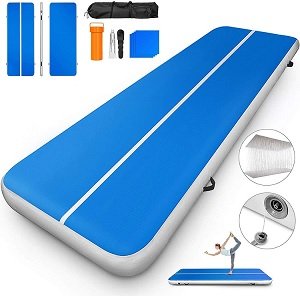A tumble track is an inflatable piece of equipment designed to provide a safe and fun way for gymnasts and athletes to practice their tumbling skills. It’s great for improving coordination, balance, and strength. It also makes practicing skills like somersaults, back handsprings, and even aerial maneuvers easier. Whether a beginner or an experienced gymnast, you can benefit from using a tumble track. In this blog post, we will define a tumble track, its benefits, training tips, and the most important precautions to take.
Table of Contents
The Benefits of Using a Tumble Track
Tumble Track Training Tips
Safety Precautions to Take When Choosing a Tumble Track
What Is a Tumble Track?
A tumble track, also known as an air track or a foam pit, is an inflatable air track made of strong and durable PVC material designed for gymnastics and other sports activities. The track typically ranges from 10-20 feet long and can be used by gymnasts of all ages and skill levels. It can be used indoors and outdoors and can be inflated to different sizes and shapes, depending on the size of the desired training area.
A tumble track is usually placed on a flat surface with a low profile, so athletes can practice various flips and tumbling moves safely. The great thing about tumble tracks is that they provide a soft landing surface and can easily be deflated and transported to different locations. They are also very affordable compared to other gymnastic apparatuses.
The Benefits of Using a Tumble Track
Using a tumble track, you can work on basic skills such as forward and backward rolls, cartwheels, and handstands, as well as more complex skills like walkovers and aerials. Working out on a tumble track provides you with the support and cushion needed to safely work on these skills. Additionally, you can use the elevated edges of the track to practice leaps and jumps and other techniques.
The increased surface area of a tumble track can also provide a bigger area for gymnasts to practice their tumbling routines. Furthermore, it helps prevent injuries since the foam cushioning lessens the impact of landings. The air-filled track absorbs some impacts as athletes land, reducing fatigue and enabling athletes to get more out of their training sessions. As an added benefit, the track’s design helps prevent slippage when performing skills, allowing you to work on your technique without worrying about slipping or losing control.
Tumble Track Training Tips
When using a tumble track, it is important to start by warming up with light stretches and other exercises that target the muscles used in tumbling. After this, you should get on the tumble track and walk or jog through your tumbling sequence. Keep your arms and legs as straight as possible, and keep your feet apart when walking. This will help you gain balance and control when you are tumbling. Take your time and get used to the feeling of the surface and the sensation of tumbling on it.
Once comfortable walking through your sequence, you can move on to running and tumbling. When running, focus on maintaining the same form as when walking. Make sure to use the proper techniques for each tumbling pass and stay focused on keeping your body straight. Once you get comfortable with running and tumbling, it’s time to take it up a notch!
Add twists, flips, and other tricks to your tumble track routine for more advanced tumblers. When practicing these advanced moves, always start slow and focus on getting the proper form down before progressing. Finally, practicing landing correctly when doing any flip or twist is important. Landing correctly will help you avoid injury and increase the effectiveness of your routine. Keep in mind that tumbling requires dedication and discipline to be successful.
Safety Precautions to Take When Choosing a Tumble Track
To ensure your tumble track is safe, consider the following precautions:
1. Be sure to purchase a certified tumble track that meets safety standards. Make sure to check the certification label on the product to make sure it has been certified.
2. Check the tumble track’s foam padding to ensure it is thick enough to provide adequate cushioning and protection against injury.
3. Ensure the surface area of the tumble track is non-slip. This will prevent any slipping or sliding when using the tumble track.
4. Check for sharp edges or metal parts that could cause injury.
